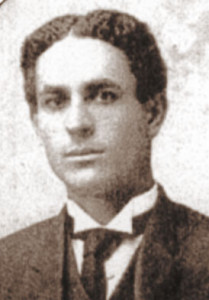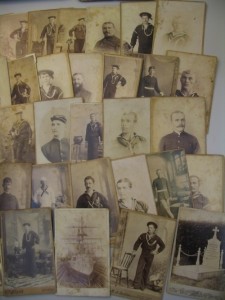This is the 10th post in the February Photo Collage Festival and the Family History Writing Challenge, and the last post in the present series about the Hugh Marion Reed Averette family. Today I am going to write about Hugh Reed Averette’s US Navy experience.
Hugh joined the US Army on July 13, 1898 in Indianapolis, Indiana. He was discharged on November 13, 1898 in Willets Pointe, Queens, New York. He joined the US Navy a month later on December 8, 1898 in New York City. He worked as a Coal Passer on the USS Newark. The Newark saw action in South America and Asia. In 1900, Hugh was in China. Here is a description of the ship’s activity during the time Hugh was a member of the crew from The Dictionary of American Fighting Ships.
The USS Newark
Departing New York 23 March 1899, the cruiser steamed down the coast of South America on patrol, stopping at numerous ports along the way. In the middle of her cruise 7 April, she was ordered to proceed through the Straits of Magellan to San Francisco. The ship, low on coal, was forced to put into Port Low, Chile, from 31 May to 22 June to cut wood for fuel. Finally arriving Mare Island Navy Yard 4 September, Newark underwent repairs and then sailed 17 October via Honolulu for the Philippines arriving Cavite 25 November. The warship took station off Vigan, Luzon, landed troops for garrison duty, then moved on to Aparri 10 December, receiving the surrender of insurrectionists in the provinces of Cagayan, Isabela, and Bataan.
On 19 March 1900, she sailed for Hong Kong to rendezvous with monitor Monadnock 22 March and convoy that ship to Cavite, arriving 3 April and staying there until sailing for Yokohama 24 April, arriving 3 days later. The ship then hoisted the flag of Rear Admiral Louis Kempff, Assistant Commander of the Asiatic Station and sailed 20 May for China to help land reinforcements to relieve the legations tinder siege by the Boxers at Peking. Arriving Tientsin 22 May, Newark operated in that port and out of Taku and Chefoo, protecting American interests and aiding the relief expedition under Vice Admiral Seymour, R.N., until sailing at the end of July for Kure, Japan, and then Cavite where she hoisted the pennant of the Senior Squadron Commander in the Philippines. She sailed for home in mid-April 1901, via Hong Kong, Ceylon and Suez, arriving Boston late July 1901. She decommissioned there 29 July.
______________
Hugh Marion Reed Averette left the Navy on December 2, 1901, in Boston, Massachusetts. He returned to Indianapolis, Indiana and resumed life as a civilian.
Other stories in the series about my Uncle Hugh Marion Reed Averette
Hugh Marion Reed Averette 1876 – 1953
Blanche Celeste Reed aka Celeste J. Averette 1887 – 1988
Anna Roberta Reed Averette Flores 1907 – 1987
Hugh Marion Reed Averette – 1910 – 1993
Theresa Pearl Reed Averette Shaffer 1913 – 1941
Thomas Perry Reed Averette 1915 – 1986


Once again a well researched, thorough and interesting story. Isn’t it remarkable how much is “out there” once we go digging.
It really is.
Hi Kristin – This is a great post and makes me want to read more history – I know nothing about the Boxer Rebellion and I suspect this is part of what we’re talking about here, yes? The photo collage of the crew is great – do you have those photos in your collection too? Wow, if you do. The Newark is such a big ship and still under sail – it looks such an anachronism in this day and age. Alex
Alex, yes, we’re talking about the Boxer Rebellion and I was surprised to find that it was going on as the same time as the Spanish American war. I am learning and remembering more history doing family research than I did in school. I’m pretty sure the Newark was not a sailing ship, otherwise my uncle Hugh would not have been down there passing coal to keep it going. I had the same thought though.
No, those photos aren’t in my collection. They are for sale on ebay for over $649. There’s a link under the photo if you’re interested 🙂
I know next to nothing about the Boxer Rebellion, and the Opium Wars, other than that they happened. Following on your post and a book I read last week I’m inspired to pursue them further, now all I need is time and more time.
Handsome guy, your Hugh!
Indeed he was.
You have covered two wars that I know absolutely nothing about – The Boxer Rebellion and the Spanish American War. Hugh had a wide experience in the Navy for sure.
I do know quite a bit about the Spanish American War and a bit about the Boxer Rebellion but I was surprised to find a family member there.
I am finding the link to “The Dictionary of American Fighting Ships” interesting. I am looking up the ships that my grandfather was on and comparing the information to his journal. Although I don’t personally have my grandfather’s Navy journal, I put a transcription and some photos online here: http://cityclicker.net/brennan/FBjournal.htm
I find it fascinating he left one service to join another. What a steam into history this ship took. I think by this time the sails were a secondary power source for use for extra power with favourable winds or in case of engine failure.
I think there was more to it than just switching services, perhaps engineered by the army because they needed more people down there in the hole shoveling coal. I’m surprised they were still using sailing ships in WW 1.
Very interesting. Thanks for sharing you post with us.
That’s great that you have so much detail about Hugh’s experience and the research about the wars is interesting too.
Hugh certainly saw and did many things during his time in service — not a dull moment!
A fascinating story that must have given Hugh quite an experience. The USS Newark was a ship of the pre-dreadought era when steamships powered by coal also used sails to supplement long ocean voyages. I have a story for a future post on a navy band from a 1900s US Navy battleship, and I’ve found a postcard showing the fireman/coal passers working below decks that I thought would illustrate what a difficult job it was to run a steamship.
I look forward to that post and seeing the postcard.
Hard to imagine such a handsome man with his shirt and tie, and well groomed,
getting his fingers dirty with such a job. He cleaned up nicely, I warrant.
Even the handsome have to work to buy those shirts and ties. He had laboring jobs all his life but I bet he never had as dirty a one as on that ship.